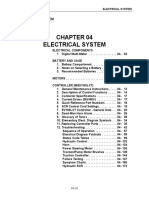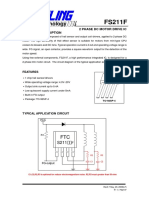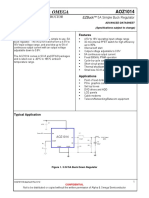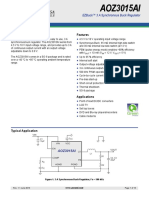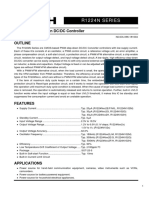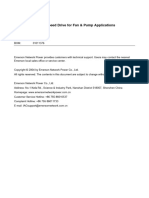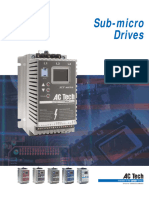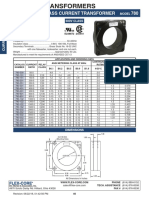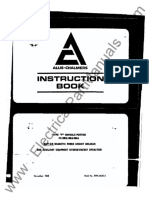CH 3-Wiring
CH 3-Wiring
Uploaded by
Sơn Lê CaoCopyright:
Available Formats
CH 3-Wiring
CH 3-Wiring
Uploaded by
Sơn Lê CaoOriginal Title
Copyright
Available Formats
Share this document
Did you find this document useful?
Is this content inappropriate?
Copyright:
Available Formats
CH 3-Wiring
CH 3-Wiring
Uploaded by
Sơn Lê CaoCopyright:
Available Formats
VFD-V Series
CHAPTER 3 WIRING
DANGER
Hazardous Voltage
Before accessing the AC drive:
Disconnect all power to the AC drive.
Wait five minutes for DC bus capacitors discharge. 3
Any electrical or mechanical modification to this equipment without prior written
consent of Delta Electronics, Inc. will void all warranties and may result in a safety
hazard in addition to voiding the UL listing.
Short Circuit Withstand:
The rated voltage must be equal to or less than 240V (460V model is 480Volts) and the current
must be equal to or less than 5000A RMS. (the model of 51HP or above is 10000A RMS)
General Wiring Information
Applicable Codes
VFD-V AC drives (007V23/43A, 015V23/43A, 022V23/43A, 037V23/43A, 055V23/43A,
075V23/43A, 110V43B, 110V23/43A, 150V23/43A, 185V23/43A, 220V23/43A, 300V23/43A,
370V23/43A, 450V43A) are Underwriters Laboratories, Inc. (UL) and Canadian Underwriters
Laboratories (cUL) listed, and therefore comply with the requirements of the National Electrical
Code (NEC) and the Canadian Electrical Code (CEC).
Installation intended to meet the UL and cUL requirements must follow the instructions
provided in “Wiring Notes” as a minimum standard. Follow all local codes that exceed UL and
cUL requirements. Refer to the technical data label affixed to the AC drive and the motor
nameplate for electrical data.
The "Line Fuse Specification" in Appendix B, lists the recommended fuse part number for each
V-Series part number. These fuses (or equivalent) must be used on all installations where
compliance with U.L. standards is a required.
DELTA ELECTRONICS, INC. ALL RIGHTS RESERVED 3-1
VFD-V Series
3.1 Basic Wiring Diagram
For wiring of the inverter, it is divided into the main circuit and the control circuit. Users
could open the case cover, and could inspect the main circuit terminal and the control circuit
terminal; users connect the circuit in compliance with the following wiring method.
The following diagram is the standard wiring diagram for the VFD-V inverter.
Wiring Diagram 1
10HP(7.5kW) and below
DC choke
(optional)
Jumper
Fuse/NFB(None Fuse Breaker)
+1 B2 Motor
R/L1 R/L1 U/T1
S/L2 S/L2 V/T2
IM
T/L3 T/L3 3~
W/T3
E
E
SA
Recommended Circuit RB RA
when power supply MC
is turned OFF by a RC
fault output OFF ON RB Please refer to ontrol
MC Terminal Explanation?
+24V RC
Factory Default: FWD/STOP
SINK Mode FWD MRA
Sink REV/STOP Factory setting:
REV Operation Indication
Sw1 Multi-step 1 MRC
MI1 Multi-function Photocoupler
Source
Multi-step 2 Output 48VDC 50mA
Please refer to wiring MI2
of SINK mode and Multi-step 3 MO1 Factory default:
SOURCE mode. MI3
Multi-step 4 Frequency-Achieving Indication
Factory MI4
default Multi-step 5
MI5 MO2 Factory default:
Multi-step 6
Driver-Ready Indication
MI6
Digital Signal Common
DCM Photocoupler Common
MCM Output Terminal
* Don input voltage directly
to the above signals. Shield terminal
AFM Multi-function Analog Output
Terminal
Factory default: Output
ACM Frequency 0~ 10VDC/2mA
Analog Signal common
+10V E
3 Power supply Digital Frequency Output
+10V 20mA DFM
Terminal
5K 2 AVI Factory default: 1:1
Master Frequency Duty=50% 10VDC
1 0 to 10V 47K
4~20mA Digital Signal Common
ACI DCM
-10~+10V RS-485
AUI Serial interface
1: +EV 2: GND 3: SG-
ACM 4: SG+ 5:NC
Analog Signal Common
6: NC
Main circuit (power) terminals Control circuit terminals Shielded leads & Cable
3-2 DELTA ELECTRONICS, INC. ALL RIGHTS RESERVED
VFD-V Series
Wiring Diagram 2
15HP(11kW) and above
DC chock
(optional) VFDB
Jumper
Fuse/NFB(None Fuse Breaker)
+1 -(minus sign) Motor
R/L1 R/L1 U/T1
S/L2 S/L2 V/T2
IM 3
T/L3 T/L3 3~
W/T3
E
E
SA
Recommended Circuit RB RA
when power supply MC
is turned OFF by a RC
fault output OFF ON RB Please refer to ontrol
MC Terminal Explanation?
+24V RC
Factory Default: FWD/STOP
SINK Mode FWD MRA
Sink REV/STOP Factory setting:
REV Operation Indication
Sw1 Multi-step 1 MRC
MI1 Multi-function Photocoupler
Source
Multi-step 2 Output 48VDC 50mA
Please refer to wiring MI2
of SINK mode and Multi-step 3 MO1 Factory default:
SOURCE mode. MI3
Multi-step 4 Frequency-Achieving Indication
Factory MI4
default Multi-step 5
MI5 MO2 Factory default:
Multi-step 6
Driver-Ready Indication
MI6
Digital Signal Common
DCM Photocoupler Common
Shield terminal MCM Output Terminal
* Don input voltage directly
to the above signals. AFM Multi-function Analog Output
Terminal
Factory default: Output
ACM Frequency 0~ 10VDC/2mA
Analog Signal common
+10V E
3 Power supply Digital Frequency Output
+10V 20mA DFM
Terminal
5K 2 AVI Factory default: 1:1
Master Frequency Duty=50% 10VDC
1 0 to 10V 47K
4~20mA Digital Signal Common
ACI DCM
-10~+10V RS-485
AUI Serial interface
1: +EV 2: GND 3: SG-
ACM 4: SG+ 5:NC
Analog Signal Common
6: NC
Main circuit (power) terminals Control circuit terminals Shielded leads & Cable
DELTA ELECTRONICS, INC. ALL RIGHTS RESERVED 3-3
VFD-V Series
Wiring of SINK mode and SOURCE mode
+24V
FWD/STOP
FWD
REV/STOP
REV
Multi-step 1
MI1
Multi-step 2
MI2
Multi-step 3
MI3
Multi-step 4
MI4
Multi-step 5
MI5
Multi-step 6
MI6
Digital Signal Common
DCM
Sink
Sw1
+24V
Source FWD/STOP
FWD
REV/STOP
REV
Multi-step 1
MI1
Multi-step 2
MI2
Multi-step 3
MI3
Multi-step 4
MI4
Multi-step 5
MI5
Multi-step 6
MI6
Digital Signal Common
DCM
3-4 DELTA ELECTRONICS, INC. ALL RIGHTS RESERVED
VFD-V Series
3.2 External Wiring
Power Supply Items Explanations
Please follow the specific power
Power
supply requirement shown in
supply
APPENDIX-A.
FUSE/NFB There may be inrush current during
Fuse/NFB power up. Please check the chart of
APPENDIX B and select the correct
(Optional) fuse with rated current. NFB is
3
Magnetic optional.
contactor
Please do not use a Magnetic
Magnetic
contactor as the I/O switch of the AC
contactor
drive, this will reduce the operating
(Optional)
Input AC life cycle of the AC drive.
Line Reactor
In order to improve the input power
factor, reduces harmonics and
Zero-phase
Reactor protection from AC line
Input AC disturbances. (Surge, switching
Line spike, power flick, etc.) AC line
EMI Filter
Reactor reactor should be installed when the
(Optional) power supply capacity is 500kVA or
more and exceeds 6 times of the
inverter capacity, or the wiring
R/L1 S/L2 T/L3
+1 DC distance within 10m.
Choke
Zero phase reactors are used to
+2/B1
Braking Zero-phase reduce radio noise specify when the
Resistor
B2 Reactor audio equipments installed near the
(Ferrite inverter. Good effective for noise
U/T1 V/T2 W/T3 Core reduction on both the input and
Common output sides. Attenuation quality is
Choke) good in a wide range from AM band
Zero-phase
Reactor (Optional) to 10Mhz. Appendix B for specifies
zero phase reactors. (RF220X00A)
Output AC To reduce the electromagnetic
Line Reactor EMI filter
interference. Please refer to
(Optional)
Appendix B for detail.
Used to reduce stopping time of the
Braking
motor. Please refer to the chart on
Motor Resistor
Appendix B for specific Braking
(Optional)
Resistors.
Output AC Motor surge voltage amplitudes
Line depending on the motor cable
Reactor length. For long motor cable
(Optional) application, it is necessary installed
on the inverter output side.
DELTA ELECTRONICS, INC. ALL RIGHTS RESERVED 3-5
VFD-V Series
3.3 Main Circuit Terminal Explanations
Terminal Symbol Content Explanation
R/L1, S/L2, T/L3 Input terminals for business-used power supply
U/T1, V/T2, W/T3 Output terminals for the AC motor drivers (at the side of the motor)
Power-improved continuing terminals of the DC reactor; disconnect
+1~+2/B1
the short-circuit piece when the device is installed
Connecting terminals of the braking resistor; purchase and install
+2/B1~B2
these devices according to the selection chart
+2/B1~ Continuing terminals of the braking module (the VFDB series)
Ground terminals, please have these terminals grounded following
the third-type grounding of 230V series and the special grounding of
460V series within the electrician regulations
3.4 Control Terminal Explanations
Terminal
Symbol Explanation on the Terminal Function Factory Setting
FWD FWD RUN-STOP command
REV REV RUN-STOP command
MI1 Multi-function input selection 1 (3-wire Multi-step 1 command
STOP-designated terminal)
MI2 Multi-function input selection 2 Multi-step 2 command
MI3 Multi-function input selection 3 Multi-step 3 command
MI4 Multi-function input selection 4 Multi-step 4 command
MI5 Multi-function input selection 5 Abnormal reset command
MI6 Multi-function input selection 6 (TRG-designated EF
terminal)
DFM Digital frequency signal output 1:1
+24V Digital control signal – the common end +24V 20mA
DCM Digital control signal – the common end
RA Multi-function relay output contact (NO a) Resistive Load
RB Multi-function relay output contact (NC b)
5A(N.O.)/3A(N.C.) 240VAC
RC Multi-function relay output contact
5A(N.O.)/3A(N.C.) 24VDC
MRA Multi-function relay output contact (NO a)
MRC Multi-function relay output contact – the common Inductive Load
end 1.5A(N.O.)/0.5A(N.C.)
240VAC
1.5A(N.O.)/0.5A(N.C.)
24VDC
Refer to Pr.02-11 to
Pr.02-12
MO1 Multi-function output terminal 1 (photo coupler) Instruction during operation
3-6 DELTA ELECTRONICS, INC. ALL RIGHTS RESERVED
VFD-V Series
Terminal
Symbol Explanation on the Terminal Function Factory Setting
MO2 Multi-function output terminal 2 (photo coupler) Set up the frequency
(Max 48VDC 50mA) attained
MO3 Multi-function output terminal 3 (photo coupler) Driver ready
(Max 48VDC 50mA)
MCM Multi-function output terminal – the common end Max 48VDC 50mA
+10V Auxiliary reference power +10V 20mA
The greatest operation 3
AVI Analog voltage frequency command frequency corresponding to
0~+10V
The greatest operation
ACI Analog current frequency command frequency corresponding to
4~20mA
The greatest operation
AUI Auxiliary analog voltage frequency command frequency corresponding to
-10~+10V
The greatest operation
AFM Multi-function analog voltage output frequency corresponding to
-10~10V
ACM Analog control signal – the common end
* Analog control signal wire specification: 18 AWG (0.8 mm2), cover the isolation
twisted wire.
DELTA ELECTRONICS, INC. ALL RIGHTS RESERVED 3-7
VFD-V Series
3.5 Component Explanations
1 HP to 5 HP (VFD007V23A/43A, VFD015V23A/43A, VFD022V23A/43A, VFD037V23A/43A)
+1 +2 B1 - B2 U/T1 V/T2 W/T3
Screw Torque :
18Kgf-cm
Wire Gauge :
18~10AWG
R/L1 S/L2 T/L3
Control Terminal
Torque: 8Kgf-cm (6.9 in-lbf)
Wire: 22-14 AWG
Power Terminal
Torque: 18 kgf-cm (15.6 in-lbf)
Wire Gauge: 18-10 AWG
Wire Type: Stranded Copper only, 75°C
3-8 DELTA ELECTRONICS, INC. ALL RIGHTS RESERVED
VFD-V Series
7.5 HP to 15 HP (VFD055V23A/43A, VFD075V23A/43A, VFD110V43B)
POWER IM
3 MOTOR
Control Terminal
Torque: 8Kgf-cm (6.9 in-lbf)
Wire: 22-14 AWG
Power Terminal
Torque: 30 kgf-cm (26 in-lbf)
Wire Gauge: 12-8 AWG
Wire Type: Stranded Copper only, 75°C
Note: If wiring of the terminal utilizes the wire with a 6AWG-diameter, it is thus
necessary to use the Recongnized Ring Terminal to conduct a proper wiring.
DELTA ELECTRONICS, INC. ALL RIGHTS RESERVED 3-9
VFD-V Series
15HP to 30HP (VFD110V23A/43A, VFD150V23A/43A, VFD185V23A/43A,
VFD220V23A/43A)
R/L1 S/L2 T/L3 +1 +2 - V/T2 W/T3
POWER DC (+) DC ( - ) IM
3 MOTOR
Control Terminal
Torque: 8Kgf-cm (6.9 in-lbf)
Wire: 22-14 AWG
Power Terminal
Torque: 30 kgf-cm (26 in-lbf)
Wire Gauge: 8-2 AWG
Wire Type: Stranded Copper only, 75°C
NOTE: If wiring of the terminal of VFD220V23A utilizes the wire with a 1AWG-diameter, it
is thus necessary to use the Recognized Ring Terminal to conduct a proper
wiring.
3-10 DELTA ELECTRONICS, INC. ALL RIGHTS RESERVED
VFD-V Series
40 to 50 HP 230V (VFD300V23A, VFD370V23A)
3
POWER
ALARM
CHARGE
R/L1 S/L2 T/L3 +1 +2 U/T1 V/T2 W/T3
Screw Torque: IM
POWER 200kgf-cm (173in-lbf) 3 MOTOR
Control Terminal
Torque: 8Kgf-cm (6.9 in-lbf)
Wire: 22-14 AWG
Power Terminal
Torque: 200 kgf-cm (173.6 in-lbf)
Wire Gauge: 1/0 – 4/0 AWG
Wire Type: Stranded Copper only, 75°C
DELTA ELECTRONICS, INC. ALL RIGHTS RESERVED 3-11
VFD-V Series
40HP to 60HP 460V (VFD300V43A, VFD370V43A, VFD450V43A)
POWER
ALARM
CHARGE
R/L1 S/L2 T/L3 +1 +2 - U/T1 V/T2 2/T3
IM
POWER 3 MOTOR
Control Terminal
Torque: 8Kgf-cm (6.9 in-lbf)
Wire: 22-14 AWG
Power Terminal
Torque: 57 kgf-cm (49.5 in-lbf)
Wire Gauge: 4-2 AWG
Wire Type: Stranded Copper only, 75°C
3-12 DELTA ELECTRONICS, INC. ALL RIGHTS RESERVED
VFD-V Series
75-100 HP 460V (VFD550V43A, VFD750V43A)
R/L1 S/L2 T/L3 +1 +2 U/T1 V/T2 W/T3
S c rew T orque:
POWER 200k gf-cm MOT OR
Control Terminal
Torque: 8Kgf-cm (6.9 in-lbf)
Wire: 22-14 AWG
Power Terminal
Torque: 200 kgf-cm (173.6 in-lbf)
Wire Gauge: 1/0 – 4/0 AWG
Wire Type: Stranded Copper only, 75°C
DELTA ELECTRONICS, INC. ALL RIGHTS RESERVED 3-13
VFD-V Series
3.6 Wiring Notice
1. There are corresponding ring terminals which will be included with each unit (15-30HP),
and please use the proper crimping tool by KST INC. P/N: KST-HDC38A for securing
the conductor.
2. When wiring up, and that the wiring route specifications are settled, please conduct the
wiring following the electrician regulations.
3. The connection between the three-phase AC input power and the main circuit terminal
R/L1, S/L2, T/L3 has to set up a none-fusing switch in between. The best is to series
connect with an electro-magnetic contactor (MC) so as to cut off the power supply at the
same time when the inverter protection function acts. (The two ends of the
electro-magnetic contactor should have the R-C Varistor).
4. There is no phase-order differentiation in the input power R/L1, S/L2, T/L3 and users
could connect with either one of use.
5. The ground terminal E is grounded with the third-type grounding method (with the
grounding impedance under 100Ω).
6. The grounding wire of the inverter could not be grounded at the same time with
machinery with grand current loading, like that of the electric soldering machine and of
the motor with grand horsepower; they have to be grounded individually.
7. The shorter the ground wire, the better it is.
8. When several inverters are grounded at the same time, be sure not to make it into a
ground circuit. Please refer to the following diagram:
FWD RUN
9. If the output terminals U/T1, V/T2 and W/T3 of the inverter are connecting relatively to
the U, V, and W terminals of the motor, the FWD indicator located on the digital control
panel of the inverter will be lit, and that means the inverter is running forward, and the
rotation direction of the motor will be shown as the right hand side diagram above; if the
REV indicator is lit, it means that the inverter is running in reverse direction, and the
rotation direction will be of the opposite direction compared with the above diagram. If
users are not sure of whether the connection between output terminals U/T1, V/T2 and
W/T3 of the inverter is of one-to-one connection with U, V, and W terminals of the motor,
simply swap either two wires among the U, V, and W terminals of the motor for
correction if the inverter is running forward while the motor is running at reverse
direction.
3-14 DELTA ELECTRONICS, INC. ALL RIGHTS RESERVED
VFD-V Series
10. Be sure of the power voltage and the greatest current possible supplied.
11. When the “Digital Hand-held Programming Panel” is displayed, please do not
disconnect or dissemble any wiring.
12. No braking resistor is installed within the VFD-V inverter (selective purchasing item),
therefore, be sure to purchase and install the braking resistor if to be used on occasions
when the loading inertia is great or that it is of frequent start/stop.
13. Be sure not to connect the AC power with the terminals U/T1, V/T2 and W/T3 on the
power-generating side of the inverter. 3
14. Please tightly fasten the screws of the main circuit terminals so as to prevent sparks
generated due to the vibration and loosening of the screws.
15. Wiring of the main circuit and of the control circuit should be separated so as to prevent
erroneous actions. If the interlock connection is needed, please make it an
intersection of 90°.
16. If terminals U/T1, V/T2 and W/T3 on the power-generating side of the inverter is in need
of the noise wave-filter, it is then necessary to use the induction-type L-Varistor, but be
sure not to add in the phase-carrying capacitor or the L-C- and R-C-type wave filters.
17. Please use the separating wire as much as possible during control wiring, and be sure
not to expose the peeled-off separation net in front of the terminal to the external.
18. Please use the separating wire or tube as much as possible during power wiring, and
ground these two ends of the separating layer or tube to the ground.
19. If the installation site of the inverter is sensitive to interferences, please have the RFI
wave filters installed, and the nearer the inverter to the installation site, the better. In
addition, the lower the carrier wave frequency of, the less the interferences.
20. If the electric-leakage circuit breaker is installed in the inverter, it could serve as the
protection for the electric-leakage error, and as the prevention on the erroneous actions
of the electric-leakage circuit breaker; please select the sensor current above 200mA
with the action time of more than 0.1 second to have these actions accessible.
DELTA ELECTRONICS, INC. ALL RIGHTS RESERVED 3-15
You might also like
- 3G3JZ Manual BasicDocument21 pages3G3JZ Manual BasicTran Le83% (6)
- EPC 100 Manual InstructionDocument1 pageEPC 100 Manual Instructionjroyal692974No ratings yet
- FR600 Series User Manual en V1.22017Document144 pagesFR600 Series User Manual en V1.22017RICHARDNo ratings yet
- Mcargas Elec FB20XDocument152 pagesMcargas Elec FB20XFútbol y másNo ratings yet
- Installation Manual WSDocument56 pagesInstallation Manual WSNaomi LimNo ratings yet
- Report On Security System Switcher (Oct 2011)Document19 pagesReport On Security System Switcher (Oct 2011)scribdsunshineNo ratings yet
- Basic Wiring Diagram - Delta VFD-V Series User MaDocument1 pageBasic Wiring Diagram - Delta VFD-V Series User MaPhan Thanh BảoNo ratings yet
- VFD-M Manual EN 20150831-Trang-2Document1 pageVFD-M Manual EN 20150831-Trang-2edmnamtienhaiNo ratings yet
- Microsoft Word - 5011203309-SE09Document1 pageMicrosoft Word - 5011203309-SE09JORGE RODNo ratings yet
- VFD-EL-W Series: Delta Sensorless Vector Control Compact DriveDocument12 pagesVFD-EL-W Series: Delta Sensorless Vector Control Compact Drivedaniel serafimNo ratings yet
- VfdelwDocument11 pagesVfdelwHalil YakışanNo ratings yet
- DELTA VFD-L Quickstart ManualDocument16 pagesDELTA VFD-L Quickstart ManualManojh sebastienNo ratings yet
- Temp 13083111391929Document13 pagesTemp 13083111391929sebas ruizNo ratings yet
- Delta Ia-Mds Vfd-E C en 20180301 WebDocument16 pagesDelta Ia-Mds Vfd-E C en 20180301 WebeeeNo ratings yet
- RM6E1 Series Simple Version Operation ManualDocument16 pagesRM6E1 Series Simple Version Operation ManualmvlNo ratings yet
- 8-DELTA-VFD-E-Vector-DrivesDocument16 pages8-DELTA-VFD-E-Vector-Driveswaseem77745alsofeeNo ratings yet
- FR100 Series User Manual EN V1.320150325Document121 pagesFR100 Series User Manual EN V1.320150325MD SHAHIN MIANo ratings yet
- DSA0051666Document9 pagesDSA0051666Vivek anandaNo ratings yet
- FR500A User Manual EN V1 0Document147 pagesFR500A User Manual EN V1 0keyur sutharNo ratings yet
- RV-1A, 2AJ - Standard Specifications Manual BFP-A8050-K (09.09)Document130 pagesRV-1A, 2AJ - Standard Specifications Manual BFP-A8050-K (09.09)TIAGO EDGAR PERININo ratings yet
- RM6E1 Series Simple Version Operation ManualDocument16 pagesRM6E1 Series Simple Version Operation Manualang.xicongNo ratings yet
- High Current Power Half Bridge: The Future of Analog IC TechnologyDocument8 pagesHigh Current Power Half Bridge: The Future of Analog IC Technologyقناة احترف بنفسكNo ratings yet
- MT9216Document9 pagesMT9216mikael tassoNo ratings yet
- Delta Ia-Mds Vfd-E C en 20200818 WebDocument16 pagesDelta Ia-Mds Vfd-E C en 20200818 Web1084No ratings yet
- Amplificador de Audio Samsung MAX DC650Document9 pagesAmplificador de Audio Samsung MAX DC650Enya Andrea Ribba HernandezNo ratings yet
- MK 0607Document10 pagesMK 0607salesiyupsNo ratings yet
- 2.5A Switch Step Down Switching Regulator: DescriptionDocument10 pages2.5A Switch Step Down Switching Regulator: DescriptionVictor CuaicalNo ratings yet
- fr150 Series User Manual en v1.2Document131 pagesfr150 Series User Manual en v1.2Hendrewel Ferreira NunesNo ratings yet
- Bosch Ic Voltage Regulator CR719 PDFDocument2 pagesBosch Ic Voltage Regulator CR719 PDFarielfoxtoolsNo ratings yet
- Bosch Regulador MultifuncionDocument2 pagesBosch Regulador Multifuncionناتاليا ناتالياNo ratings yet
- FR150 - 4T-0.7B: FR150series Inverters Fast Installation and Commissioning GuideDocument129 pagesFR150 - 4T-0.7B: FR150series Inverters Fast Installation and Commissioning Guidead adNo ratings yet
- LM Ic 3205 PDFDocument26 pagesLM Ic 3205 PDFAbu alwardNo ratings yet
- 3843ANDocument8 pages3843ANinfosolutionNo ratings yet
- Model RM4-WTDocument44 pagesModel RM4-WTchris.cottierNo ratings yet
- Catalogo inversorHNC hv390 PolicompDocument8 pagesCatalogo inversorHNC hv390 PolicompRodrigo OrfeiNo ratings yet
- Catálogo de Convertidores de Frecuencia de La Serie HV390Document9 pagesCatálogo de Convertidores de Frecuencia de La Serie HV390Nancy GutiNo ratings yet
- Technology: 2 Phase DC Motor Drive Ic General DescriptionDocument13 pagesTechnology: 2 Phase DC Motor Drive Ic General DescriptionalexNo ratings yet
- FR100 Series User Manual en V1.5 20180511Document131 pagesFR100 Series User Manual en V1.5 20180511RICHARD0% (2)
- MP5461Document20 pagesMP5461vamsidbuildsNo ratings yet
- General Description Features: EzbuckDocument9 pagesGeneral Description Features: EzbuckCristina NistorNo ratings yet
- AOZ2023PIDocument11 pagesAOZ2023PIjuliocunachiNo ratings yet
- PM174 Powermeter: Quick Start GuideDocument11 pagesPM174 Powermeter: Quick Start Guideusamakhan205No ratings yet
- DC DrivesDocument54 pagesDC DrivesmahalakshmiNo ratings yet
- Peak 3A Bus Termination RegulatorDocument12 pagesPeak 3A Bus Termination RegulatormkubawatNo ratings yet
- AOZ3015AIDocument14 pagesAOZ3015AIIcomNo ratings yet
- 36V/3A 500Khz Synchronous Step-Down Converter: FeaturesDocument10 pages36V/3A 500Khz Synchronous Step-Down Converter: FeaturesDmitrNo ratings yet
- MP 18851Document35 pagesMP 18851Hamza HammadiNo ratings yet
- Fairchild - Semiconductor FAN73611MX DatasheetDocument14 pagesFairchild - Semiconductor FAN73611MX DatasheetDeddy WilopoNo ratings yet
- Hxh2kz TCS9708 DatasheetDocument9 pagesHxh2kz TCS9708 DatasheetprreNo ratings yet
- Full-Bridge DMOS PWM Motor Drivers: A4952 and A4953Document11 pagesFull-Bridge DMOS PWM Motor Drivers: A4952 and A4953jonathan.boussoir2215No ratings yet
- High Efficiency 3A, 16V, 500Khz Synchronous Step Down ConverterDocument15 pagesHigh Efficiency 3A, 16V, 500Khz Synchronous Step Down ConverterkadirovNo ratings yet
- A4950 DatasheetDocument9 pagesA4950 DatasheetIndra KurniawanNo ratings yet
- HLSR-P SeriesDocument13 pagesHLSR-P SeriesGerson David Reto PeñaNo ratings yet
- Driver Backlight PSP 2000Document12 pagesDriver Backlight PSP 2000Jhonny GuillermoNo ratings yet
- UC3842ANDocument8 pagesUC3842ANLourencosud SudNo ratings yet
- Mesa Motion ControllerDocument2 pagesMesa Motion ControllerArvinder SinghNo ratings yet
- Delta Ia-Mds Vfd-El-W C en 20220215Document12 pagesDelta Ia-Mds Vfd-El-W C en 20220215Álisson SilveiraNo ratings yet
- BD-201 Roller Driver User ManualDocument9 pagesBD-201 Roller Driver User ManualPhạm BìnhNo ratings yet
- DatasheetDocument9 pagesDatasheetjim campbellNo ratings yet
- U10 R1224N102HDocument41 pagesU10 R1224N102HNATHANEASTBOUNDNo ratings yet
- FP5452 FeelingTechnologyDocument26 pagesFP5452 FeelingTechnologymartin sembinelliNo ratings yet
- Creston DC5Document1 pageCreston DC5produtos.hunterNo ratings yet
- MP3394 r1.07 PDFDocument17 pagesMP3394 r1.07 PDFAnonymous biMSzTyszNo ratings yet
- Reference Guide To Useful Electronic Circuits And Circuit Design Techniques - Part 2From EverandReference Guide To Useful Electronic Circuits And Circuit Design Techniques - Part 2No ratings yet
- CH 5-ParametersDocument82 pagesCH 5-ParametersSơn Lê CaoNo ratings yet
- VFD-G Manual enDocument119 pagesVFD-G Manual enSơn Lê CaoNo ratings yet
- PV User ManualDocument92 pagesPV User ManualSơn Lê CaoNo ratings yet
- Baking ModulesDocument22 pagesBaking ModulesSơn Lê CaoNo ratings yet
- Ac Tech Sub Micro Drives Overview - Data SheetDocument8 pagesAc Tech Sub Micro Drives Overview - Data SheetSơn Lê CaoNo ratings yet
- Idecpg04 00Document20 pagesIdecpg04 00Sơn Lê CaoNo ratings yet
- 3AUA0000012131Document46 pages3AUA0000012131Sơn Lê CaoNo ratings yet
- Instruction Manual S 400Document29 pagesInstruction Manual S 400Sơn Lê CaoNo ratings yet
- Datasheet S 400Document2 pagesDatasheet S 400Sơn Lê CaoNo ratings yet
- 819-Tw-E-102 Electrical LT Block Diagram LT Block Diagram r1 (1) - OzoraDocument1 page819-Tw-E-102 Electrical LT Block Diagram LT Block Diagram r1 (1) - OzoraMichael NgoNo ratings yet
- Electricity and Circuits WorksheetDocument3 pagesElectricity and Circuits WorksheetZarghoona86% (7)
- Cap 220pF 2kVDocument12 pagesCap 220pF 2kVJoão Oliveira BentesNo ratings yet
- GFCI Receptacle Tester Instructions CraftsmanDocument1 pageGFCI Receptacle Tester Instructions Craftsmanvomofe1666No ratings yet
- Sepam Protection 20 and 40Document80 pagesSepam Protection 20 and 40Thức VõNo ratings yet
- One-Line Diagram - OLV1 (Load Flow Analysis) : Scheme-1Document1 pageOne-Line Diagram - OLV1 (Load Flow Analysis) : Scheme-1EILA545 QAQCNo ratings yet
- Smart Transformer Station 6000K Series Datasheet - Draft - 2018428 - EUDocument2 pagesSmart Transformer Station 6000K Series Datasheet - Draft - 2018428 - EULorenzo25% (4)
- Valbia Actuator SetupDocument1 pageValbia Actuator SetupkikinNo ratings yet
- Pe & MatlabDocument67 pagesPe & MatlabChandu KrishnaNo ratings yet
- Datasheet Blue Solar Charge Controller MPPT 150 70 & 150 85 enDocument1 pageDatasheet Blue Solar Charge Controller MPPT 150 70 & 150 85 enFrancisco TorrealbaNo ratings yet
- Comparision of Direct-On-Line DOL and Star-Delta Motor StartingDocument6 pagesComparision of Direct-On-Line DOL and Star-Delta Motor Startinglam266No ratings yet
- Relay/Meter Class Current Transformer 780Document2 pagesRelay/Meter Class Current Transformer 780alejandrozabalaNo ratings yet
- Problems With Commutation in Real Machines Lesson 2: What Is This Lesson About?Document8 pagesProblems With Commutation in Real Machines Lesson 2: What Is This Lesson About?Russel BubanNo ratings yet
- MPW Manual Motor Protectors - Technical Data: Low Voltage Industrial ControlsDocument5 pagesMPW Manual Motor Protectors - Technical Data: Low Voltage Industrial ControlsDEPARTAMENTO ELECTRONICA FASEELNo ratings yet
- ElectricasDocument1 pageElectricasAngel Lazarte DueñasNo ratings yet
- 17EN IMC CAT ACBHW Eb SRGB PDFDocument92 pages17EN IMC CAT ACBHW Eb SRGB PDFJoyceYap100% (1)
- Pad Mounted Transformer Instruction Manual3Document19 pagesPad Mounted Transformer Instruction Manual3alcibiades romeroNo ratings yet
- A-CBR108-201-EN Dynamic Contact Resistance Measurement (DRM)Document4 pagesA-CBR108-201-EN Dynamic Contact Resistance Measurement (DRM)levanthanhbkaNo ratings yet
- LT-949 MIR-65 Installation InstructionsDocument2 pagesLT-949 MIR-65 Installation InstructionssanjayswtNo ratings yet
- X.pos Plus Digital Readout System Operation Manual: Always Committed To Quality, Technology & InnovationDocument126 pagesX.pos Plus Digital Readout System Operation Manual: Always Committed To Quality, Technology & InnovationNandita GuatemalNo ratings yet
- Logic Gate Families: Learning ObjectivesDocument23 pagesLogic Gate Families: Learning Objectiveskalyan100% (1)
- 02-El-Rep-B+G+2-Wro Aynalem YohannesDocument17 pages02-El-Rep-B+G+2-Wro Aynalem YohannesdawitgggNo ratings yet
- BWX 6630 4Document62 pagesBWX 6630 4Karin AndersonNo ratings yet
- Quote 1189 - CustomerDocument2 pagesQuote 1189 - CustomerrumbidzamakuvazaNo ratings yet
- Institut Teknologi Del: Elektronika 1Document3 pagesInstitut Teknologi Del: Elektronika 1Yohana Crisma LimbongNo ratings yet
- Hyosung Heavy Industries: EPC ContractorDocument71 pagesHyosung Heavy Industries: EPC ContractorEdciel EbuenNo ratings yet



